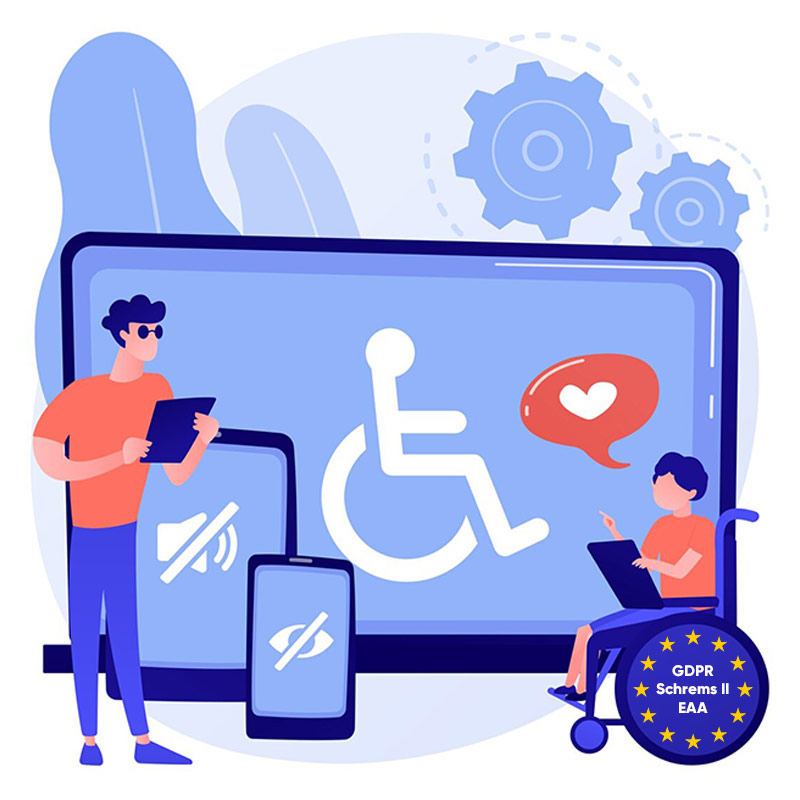Zugänglichkeit / Accessibility (a11y) für Websites | WCAG & EEA
- Accessibility Widget
- Accessibility Scan / Audit
- Accessibility Statement
- Konformität mit ADA, AODA, EAA, WCAG-basiert

Accessibility Scan / Audit
Entdecken Sie Zugänglichkeitsprobleme auf Ihrer Website oder in Ihrem Webshop
- WCAG 2.2-Kriterien
- Identifizierung kritischer Probleme, Erklärung und Vorschläge zur Behebung
- Anzeige von bestandenen Audits, erforderliche manuelle Audits
- Einmalige Scans (Bezahlung pro Scan)
- Regelmäßige Scans
Accessibility Statement
Konformität mit Zugänglichkeitsgesetzen wie dem ADA und der EAA (WCAG-basiert)
- Einbettbares Dokument, das den Grad der Übereinstimmung mit der EAA und den WCAG-Standards darlegt
- Beschreibung der Zugänglichkeit der Website
- Bekannte Probleme mit der Zugänglichkeit
- Feedback-Mechanismus zur Zugänglichkeit / Anweisungen, wie Nutzer Probleme melden oder Alternativen anfordern können
Want to know when we go live?
Barrierefreiheit insights / Blog
Häufig gestellte Fragen (FAQ)
a11y“ ist die Abkürzung für ‚accessibility‘ (Zugänglichkeit), wobei die elf Buchstaben ‚ccessibilit‘ durch die Zahl 11 ersetzt werden. Es bezieht sich auf die Zugänglichkeit für Benutzer und ist in unserem Fall der Name unseres Zugänglichkeitstools: UserA11y.
Digital accessibility refers to the practice of designing websites, apps, and other digital content so that people with disabilities can use them effectively. It involves ensuring that digital products are usable by everyone, regardless of their ability to see, hear, move, or process information.
Accessibility is crucial because it ensures that all users, including the 15% of the world’s population who experience some form of disability, have equal access to information and functionality. It promotes inclusivity and is often required by law in many regions.
Common issues include lack of keyboard navigability, insufficient color contrast, missing alternative text for images, reliance on audio or visual content without text alternatives, and complex or inconsistent navigation.
The Web Content Accessibility Guidelines (WCAG) are a set of recommendations for making web content more accessible. They are important because they provide a clear standard for developers to follow and are often part of legal requirements for accessibility compliance.
To make text more accessible, use sufficient contrast between text and background, employ scalable font sizes, allow for text spacing adjustments, and choose legible fonts. Additionally, organizing content into clearly defined sections with appropriate headings helps users navigate and understand content more easily.
Various tools can help test digital accessibility, including automated web accessibility evaluation tools like UserA11y, WAVE, AXE, and Lighthouse. Screen readers like JAWS, NVDA, or VoiceOver also provide insight into how accessible a website is for non-sighted users.
Ensure that all multimedia content, such as videos and audio, have captions and transcripts. For videos, also include audio descriptions of key visual elements to assist users who are visually impaired.
Accessible Rich Internet Applications (ARIA) is a set of special accessibility attributes that can be added to HTML elements to enhance accessibility. ARIA should be used when HTML alone cannot make certain web content accessible. However, using native HTML elements which inherently support accessibility is preferable.
Accessibility features often improve the overall user experience for everyone. Features such as clear navigation, voice control, and text resizing can enhance usability for users in different contexts, such as those accessing a site on a mobile device, in a noisy environment, or with temporary injuries.
Apart from using an accessibility widget such as UserA11y, organizations can improve accessibility by incorporating accessibility into their design and development processes, regularly training staff on accessibility issues, conducting audits using both automated tools and human testers, and establishing clear policies and procedures for maintaining accessibility standards.